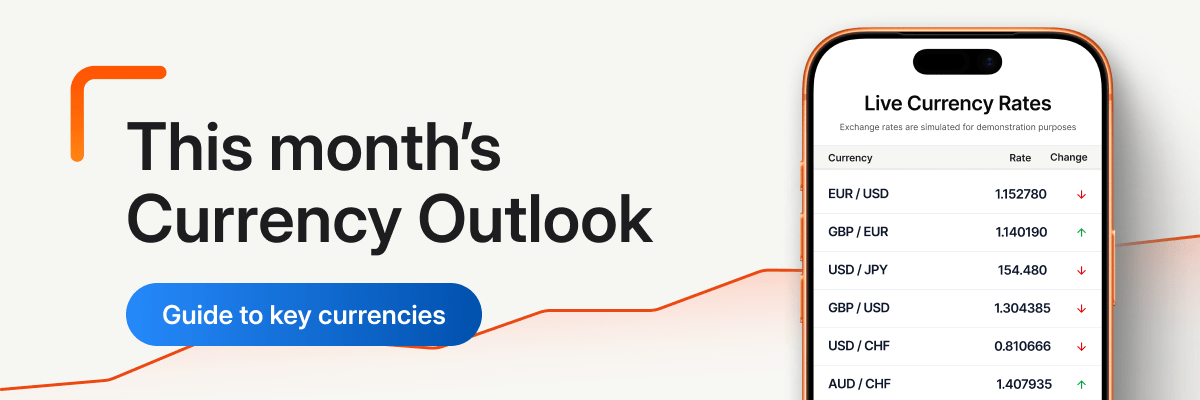The below key drivers are likely to impact investor risk sentiment and FX markets in November:
- Markets were anticipating the Federal Reserve to cut interest rates at its next meeting, but as the economy continues to underperform, future cuts would likely be gradual.
- The US government shutdown has disrupted timely access to data on economic indicators, allowing currency volatility to be modest and orderly.

EUR | Euro
The euro slipped as the dollar stays strong, with stable Eurozone inflation and rates held steady. Markets now wait on US data and signs of life from Germany’s factories.
October saw mixed performance from the EURUSD. With the US dollar’s strength over recent weeks, EURUSD dropped from US$1.1750 at the start of October, to below US$1.15 at the start of November.
It appears inflation in the Eurozone has stabilised close to the European Central Bank’s 2% target, with the October Flash Consumer Pricing Index (CPI) reading dipping to 2.1% y/y from 2.2%. It seems the Eurozone could see a prolonged period of interest rates being held by the European Central Bank, with its main refinancing rate expected to remain at 2.15% for the next few meetings.
Markets are hoping upcoming Eurozone PMI data will show the improvements seen over the past few months continue as we head towards 2026. Germany’s manufacturing sector is close to expansionary territory after an extended period of contracting. The ongoing US government shutdown means there has been no government data over recent weeks so should this be resolved, and we get a slew of backdated releases unveiled, there could be some big swings in EURUSD (and other currency pairs). However, it’s unclear when the shutdown will be resolved.
Expected ranges:
- EURUSD 1.1400–1.1775
- EURGBP 0.8620–0.8870
GBP | Sterling
The pound eased in October amid concerns about the UK economy and potential tax rises, though stronger retail and services data offered some support ahead of the upcoming budget.
Throughout October, the GBPUSD pair fell as financial markets were focused on the health of the UK economy.
Surveys show UK productivity had stalled, meaning Chancellor of the Exchequer, Rachel Reeves, might be forced to break an election promise – not to raise taxes on the UK public. The potential that either income tax, VAT or National Insurance could be hiked hit the pound, with GBPUSD hitting a seven-month low in early November, coming close to US$1.30. Despite the downbeat sentiment hanging over the pound, some recent data such as Services PMI and Retail Sales beat forecast. The latest IMF Economic Outlook report also predicted that UK growth would be the second best out of the G7 countries.
Looking ahead, all eyes are on the November 26 budget, which could see the first rise in the basic rate of income tax in 50 years. Should this happen, it would only partially fill the estimated £25bn black hole in the UK’s finances, so other tax rises and/or spending cuts will likely be needed to strengthen the country’s balance sheet.
Expected ranges:
- GBPUSD 1.2875–1.3400
- GBPEUR 1.1275–1.1600
AUD | Australian dollar
The Australian dollar slipped slightly in October, weighed down by weaker commodity demand and a stronger US dollar, though steady local conditions helped keep the currency broadly stable.
During October, the Australian dollar posted a mild decline against the US dollar, reflecting a month of cautious trading shaped by global market sentiment, commodity price fluctuations, and shifting interest rate expectations.
October’s trading range remained relatively tight, staying between US$0.6629 and US$0.6440, with an average monthly rate near US$0.6535. Often seen as a barometer of global growth, the AUD typically weakens when concerns about China’s economic recovery or demand for raw materials arise. During the month, subdued Chinese industrial activity and volatility in key export commodities such as iron ore and coal limited investor enthusiasm for the Australian currency.
On the domestic front, employment, consumer confidence, and business sentiment remained stable, but lacked the strength to counter external pressures. Without clear signs of accelerating growth, the AUD’s ability to gain traction remained limited. Despite the minor depreciation, the Australian dollar’s October performance, it maintained steady investor confidence rather than a sharp loss of momentum. For exporters, the softer exchange rate provided a modest advantage, enhancing the competitiveness of Australian-dollar-priced goods and services in US markets. Conversely, importers and travellers faced slightly higher costs on USD-denominated purchases.
Looking ahead, the AUD’s direction will depend largely on developments in global growth prospects, commodity demand, and the evolving interest rate landscape. A continuation of robust US data and persistent inflation could sustain USD strength, while a rebound in Chinese demand or a change from the Fed may offer support to the AUD.
Expected ranges:
- AUDUSD 0.6459-0.6562
- AUDGBP 0.4916-0.49951
- AUDEUR 0.5587-0.5698
- AUDNZD 1.1409-1.1590
NZD New Zealand dollar
The New Zealand dollar edged lower in October as global growth concerns and softer local data weighed on sentiment. Meanwhile, steady US strength kept the NZD under gentle pressure.
In October 2025, the New Zealand Dollar saw a modest decline against the US dollar, reflecting a combination of global headwinds, domestic softness and central bank cues.
At the start of the month, the NZD was trading around US$0.5817, before reaching a mid-October low near US$0.5683 and finally settling at the US$0.5759 mark by October 27.
Domestically, the Reserve Bank of New Zealand (RBNZ) signalled a dovish stance – lowering interest rates to encourage borrowing and spending. Despite the decline in NZD strength, the movement was not dramatic. Instead, it reflected modest consolidation within a risk-aware backdrop. For New Zealand exporters, the slightly weaker NZD helped ease competitiveness pressures in USD terms, while importers and travellers saw marginally higher costs for USD-priced goods and services.
Looking ahead, the NZD’s trajectory remains tied to global commodity and growth trends, the RBNZ’s next policy moves, and the USD’s broader strength. Should global growth surprise upside or New Zealand data improve significantly, the NZD could regain some ground. Conversely, if the RBNZ eases more aggressively or the USD stays firm, further modest weakening remains plausible.
Expected ranges:
- NZDUSD 0.5606-0.5745
- NZDEUR 0.4845-0.4975
- NZDGBP 0.4264-0.4368
- NZDAUD 0.8628-0.8765
USD | United States dollar
The US dollar held steady last month as solid data offset rate-cut expectations. It’s likely to stay sensitive to Fed signals, economic trends, and global risk sentiment.
Over the past month, the US dollar has shown modest resilience, despite signals pointing toward a softer US policy stance. The US Dollar Index (DXY) hovered near the 99.5 region, reflecting this balancing act between relative strength and caution. One key driver was the Federal Reserve’s (Fed) behaviour. Although a rate cut is anticipated, the Fed have emphasised that future cuts would likely be measured and strongly data-dependent.
Inflation remains sticky, and labour markets still show signs of resilience, which has helped underpin the US dollar. However, external pressures such as US federal debt, structural current account deficits and weakening foreign demand for dollar-denominated assets continue to weigh on the economy.
If incoming inflation, employment, or spending data continue to show strength, the Fed’s guidance may stay more hawkish than markets currently expect, which would support the dollar. Conversely, any signs of weakening, particularly in labour markets or activity, will heighten expectations of deeper or faster rate cuts, which could weaken the US dollar.
On the global side, a shift in risk appetite (for example via geopolitical shocks or commodity swings) could trigger safe-haven flows back into the dollar, or equally accelerate its decline if investors turn away from US assets. Barring a strong data surprise favouring the US dollar, a modest drift lower appears more likely than a sharp rally.
Expected ranges:
- DXY 99.28-100.36
JPY | Japanese yen
The yen weakened in October as Japan’s new leadership signalled looser policies. Despite rising inflation, the Bank of Japan stayed cautious, with markets watching for signs of a future rate hike.
The yen remained under pressure through October, weakening over 4.5% against the US dollar. The sell-off accelerated following the appointment of Prime Minister Sanae Takaichi, which revived expectations for looser fiscal and monetary policies and reinforced bearish sentiment toward the yen.
At its latest meeting, the Bank of Japan (BoJ) kept its policy rate unchanged at 0.50% with a 7–2 vote. Governor Kazuo Ueda reiterated that the BoJ will take a data-dependent approach to policy. While he refrained from signalling any specific timeline for future rate hikes, he noted that additional information on wage trends and inflation was needed before making further decisions.
The sharp pace of yen depreciation prompted verbal intervention from new Finance Minister Katayama, who warned against “one-sided and rapid” moves in the FX market and reiterated that authorities are monitoring developments with a high sense of urgency. While verbal comments helped slow the sell-off temporarily, they did little to alter the broader trend. Meanwhile, Tokyo CPI for October surprised to the upside, rising 2.8% YoY across headline and core measures, highlighting persistent domestic inflation pressures.
Looking ahead, markets will closely watch Japan’s wage and inflation data alongside developments in the US economy to gauge the timing of the BoJ’s next policy move. Expectations have shifted toward a potential rate hike in January 2026, but that remains contingent on sustained wage momentum and stable external conditions. Persistent yen weakness and elevated inflation readings may add pressure for earlier action, though officials are likely to proceed cautiously until there is clearer evidence of sustained wage momentum.
Expected ranges:
- USDJPY 151.10–155.00
CAD | Canadian dollar
The Canadian dollar dipped slightly as rate cuts and global pressures weighed, though steady inflation, strong jobs data, and firm oil prices offered some support for the CAD.
The Canadian dollar saw a modest decline in October, with CAD down roughly 0.7% against the US dollar.
Inflation ticked up to 2.4% in September, higher than expected, which helped support the CAD via reduced expectations of aggressive Bank of Canada (BoC) cuts. October’s employment data showed unexpected job growth, strengthening the view that Canada’s economy may be more resilient than feared. On the commodity side, oil prices (critically linked to Canada’s export mix) held up, providing some tailwind for the currency. Taken together, these forces resulted in periods of relative strength for the CAD versus the USD, even though broader US dollar strength and global risk sentiment kept the CAD under pressure.
Looking ahead, the Canadian dollar’s direction will likely hinge on three main factors: BoC policy expectations, global commodity/energy markets, and US/global risk sentiment. With the BoC having already cut to 2.50% and signalled that the easing cycle may be nearing its end, markets are now watching for any change in forward guidance or signs of renewed inflation pressure. If inflation remains sticky or employment robust, the CAD could benefit. Conversely, any softening in data may revive rate-cut expectations and weigh on the CAD.
Expected ranges:
- CADUSD 1.3985-1.4100
SGD | Singapore dollar
USDSGD rose slightly as the SGD took its cues from a firmer USD amid risk-off sentiment, following Fed Chair Powell’s cautious remarks and the ongoing US government shutdown.
USDSGD edged higher from early October to early November, rising from around 1.2861 to 1.3089, an appreciation of roughly 1.77%. The move was supported by risk-off sentiment after widely expected US-China trade negotiation and market participants also began to reassess the likelihood of a Fed rate cut in December, leading to firmer US yields and reinforcing USD gains.
In its October policy review, the Monetary Authority of Singapore (MAS) left monetary settings unchanged, maintaining a modest appreciation of the S$NEER band. This was the second straight hold following five rounds of tightening since 2021, with MAS calling its slightly restrictive stance appropriate. Inflation continues to ease gradually, core CPI fell to 3.0% in September, the lowest since March 2022, though domestic price pressures, especially in services, remain elevated. Singapore’s economy expanded by 2.9% year-on-year in Q3, easing slightly from 3.1% in Q2. Growth was led by resilient services activity, while manufacturing remained soft. The government retained its full-year GDP forecast of 1.0% to 2.0%, and core inflation target of 2.5% to 3.5%.
The S$NEER continued to ease, last seen around 1% above its model-implied midpoint, consistent with MAS’s modest appreciation stance following its October decision. From a market standpoint, a continued easing in the S$NEER suggests a milder appreciation bias for the SGD and could lend near-term support to USD/SGD, with the local currency expected to continue taking cues from broader USD movements and US yields.
Expected range:
- USDSGD 1.2850–1.3120
HKD | Hong Kong dollar
The Hong Kong dollar stayed steady in October, supported by resilient economic growth, low inflation, and matching US rate cuts, keeping markets confident and USDHKD largely unchanged.
The Hong Kong dollar held steady through October, trading within a tight range. USDHKD drifted lower from around 7.78 in early October to 7.77 by early November, briefly touching 7.76 mid-month as markets positioned ahead of the US Federal Reserve (Fed) decision. Following the Fed’s move to lower interest rates by 25 basis points, the Hong Kong Monetary Authority (HKMA) followed suit, cutting its base rate to 4.25% on October 30.
Economic data painted a resilient picture for Hong Kong. Third-quarter GDP grew 3.8% year-on-year, up from 3.1% previously, marking the 11th straight quarter of expansion. Inflation remained subdued, with CPI holding steady at 1.1% in September. While the unemployment rate ticked up slightly to 3.9% from 3.7%, retail sales provided a silver lining, accelerating to 5.9% year-on-year growth from 3.8% previously. Policymakers cited strong export performance and solid domestic demand, noting that recent Fed easing helped lift sentiment in local asset markets.
Looking ahead, USDHKD is expected to remain anchored near current levels, supported by the currency board system. If the Fed delivers another rate cut in December, Hong Kong is likely to mirror the move, keeping domestic interest rates low and reinforcing local investment appetite. Barring any external shocks that drive broad-based demand for the US dollar, sentiment in Hong Kong appears constructive.
Expected range:
- USDHKD 7.76–7.79
Political change adds pressure on the yen. Read the article.
IMPORTANT: The contents of this blog do not constitute financial advice and are provided for general information purposes only without taking into account the investment objectives, financial situation and particular needs of any particular person. OzForex Limited (trading as “OFX”) and its affiliates make no recommendation as to the merits of any financial strategy or product referred to in the blog. OFX makes no warranty, express or implied, concerning the suitability, completeness, quality or exactness of the information and models provided in this blog.





